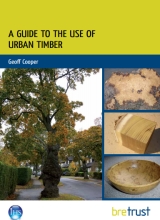A guide to the use of urban timber FB 50
BRE (Building Research Establishment) is an independent, research-based consultancy, testing and training organisation, operating in the built environment and associated industries.
A guide to the use of urban timber (FB 50) was written by Geoff Cooper and published by BRE on 31 July 2012.
Every day across the UK, thousands of tonnes of wood residue are produced through arboricultural work. However, the timber this produces is normally variable and inconsistent, resulting in problems with collection, transportation and selection. As a result, much of it is relegated to the much or firewood bin.
FB 50 is a 64-page illustrated guide to using timber from the UK’s urban timber resource, including street, park and urban woodland trees. It provides guidance on the selection and identification of high-value stems, as well as processing, drying, transport, storage and the logistical problems of dealing with felled material.
The guidance promotes the use of many common and exotic species for high-value solid wood products rather than being processed for firewood, chipped to produce mulch or sent to landfill. It is intended to help local authorities maximise the value of timber produced in towns and cities and to develop the best options for using solid wood produced during normal maintenance.
The contents of the guide are:
- Introduction.
- Material and species availability.
- Assessing stems for timber production.
- Value-added growth feature.
- A sawmill perspective.
- Timber dimensions, measurement and material grading.
- Wood drying.
- Air drying.
- The kiln drying of timber.
- Kiln drying processes.
- Drying schedules.
- Problems associated with wood drying.
- Calculating value.
- Identifying prospective markets.
- Appendix: Species list and wood property information.
- References.
[edit] Related articles on Designing Buildings Wiki
- 11 things you didn't know about wood.
- BRE articles on Designing Buildings Wiki.
- BRE Buzz articles on Designing Buildings Wiki.
- BRE Buzz.
- Building Research Establishment.
- Carpentry.
- Cat's paw figure.
- Definition of tree for planning purposes.
- Delivering sustainable low energy housing with softwood timber frame.
- Dunnage.
- End racking.
- Facts about forestry.
- Forest ownership.
- Forests.
- Physical Properties of Wood.
- Rip sawing.
- Ripple figure.
- Spalting.
- The differences between hardwood and softwood.
- Tiger-stripe figure.
- Timber preservation.
- Timber sticker.
- Timber vs wood.
- Timber.
- Tree preservation order.
- Tree rights.
- Types of timber.
- Urban trees.
- Waney edged.
Featured articles and news
The UK's Modern Industrial Strategy: A 10 year plan
Previous consultation criticism, current key elements and general support with some persisting reservations.
Building Safety Regulator reforms
New roles, new staff and a new fast track service pave the way for a single construction regulator.
Architectural Technologist CPDs and Communications
CIAT CPD… and how you can do it!
Cooling centres and cool spaces
Managing extreme heat in cities by directing the public to places for heat stress relief and water sources.
Winter gardens: A brief history and warm variations
Extending the season with glass in different forms and terms.
Restoring Great Yarmouth's Winter Gardens
Transforming one of the least sustainable constructions imaginable.
Construction Skills Mission Board launch sector drive
Newly formed government and industry collaboration set strategy for recruiting an additional 100,000 construction workers a year.
New Architects Code comes into effect in September 2025
ARB Architects Code of Conduct and Practice available with ongoing consultation regarding guidance.
Welsh Skills Body (Medr) launches ambitious plan
The new skills body brings together funding and regulation of tertiary education and research for the devolved nation.
Paul Gandy FCIOB announced as next CIOB President
Former Tilbury Douglas CEO takes helm.
UK Infrastructure: A 10 Year Strategy. In brief with reactions
With the National Infrastructure and Service Transformation Authority (NISTA).
Ebenezer Howard: inventor of the garden city. Book review.
The Grenfell Tower fire, eight years on
A time to pause and reflect as Dubai tower block fire reported just before anniversary.
Airtightness Topic Guide BSRIA TG 27/2025
Explaining the basics of airtightness, what it is, why it's important, when it's required and how it's carried out.
Construction contract awards hit lowest point of 2025
Plummeting for second consecutive month, intensifying concerns for housing and infrastructure goals.
Understanding Mental Health in the Built Environment 2025
Examining the state of mental health in construction, shedding light on levels of stress, anxiety and depression.























